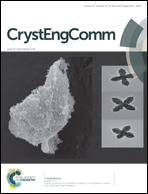Discrete 0D and polymeric 2D and 3D derivatives assembled from [(CuL)2Zn]2+ and dicyanamide blocks (H2L = salen type Schiff bases): Genuine supramolecular isomers with distinct topologies†
Abstract
Three new hetero-metallic Cu(II)–Zn(II) compounds [(CuL1)2Zn(N(CN)2)2] (1), 2∞[(CuL2)2Zn(μ1,5-N(CN)2)2]n (2A) and 3∞[(CuL2)2Zn(μ1,5-N(CN)2)2]n (2B) have been synthesized by reacting a [CuL1] or [CuL2] “metalloligand” (where H2L1 = N,N′-bis(α-methylsalicylidene)-1,3-propanediamine and H2L2 = N,N′-bis(salicylidene)-1,3-propanediamine) with zinc perchlorate hexahydrate and sodium dicyanamide, using various molar ratios of the reactants. All three products have been characterized by IR and UV-Vis spectroscopies, ESI-MS, elemental, powder and single crystal X-ray diffraction analyses. Complex 1 is a discrete 0D trinuclear species in which two “metalloligands” coordinate to a zinc(II) ion through phenoxido oxygen atoms along with two terminal dicyanamido ligands. In contrast, products 2A and 2B are 2D and 3D coordination polymers, respectively, which bear a common [(CuL2)2Zn(N(CN)2)2] trinuclear unit wherein, however, dicyanamido moieties adopt a μl,5-bridging coordination mode. The coordination networks have been formed via the linkage, in different manners, of the trinuclear nodes [(CuL2)2Zn]2+ through Zn and Cu centres with the help of divergent dicyanamido spacers. These two isomeric coordination polymers represent a rare example of “genuine supramolecular isomerism”. The coordination networks in 2A and 2B have been classified from the topological viewpoint, revealing a binodal 3,4-connected underlying net with the 3,4L21 topology in 2A and a uninodal 4-connected underlying net with the qtz (quartz, 4/6/h1) topology in 2B. Electronic spectra and ESI mass spectra show that all three complexes lose their solid state identity in solution.
![Graphical abstract: Discrete 0D and polymeric 2D and 3D derivatives assembled from [(CuL)2Zn]2+ and dicyanamide blocks (H2L = salen type Schiff bases): Genuine supramolecular isomers with distinct topologies](/en/Image/Get?imageInfo.ImageType=GA&imageInfo.ImageIdentifier.ManuscriptID=C3CE42027B&imageInfo.ImageIdentifier.Year=2014)

 Please wait while we load your content...
Please wait while we load your content...